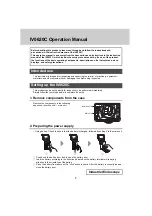
SECTION 3: TRACE ANALYSIS
This section will provide a basic overview about how to analyze an OTDR trace, and will cover the different types of information that
can be gathered from an OTDR trace, including:
– event location;
– fiber length measurement;
– fiber attenuation (loss); and
– reflectance measurement.
proper interpretation of OTDR test results requires a significant amount of technical skill, knowledge, and expertise. Proper
trace interpretation is paramount to a successful OTDR test, and the consequences of interpreting a trace incorrectly could
result in a significant amount of network down-time and repair costs.
OVERVIEW
10
The primary function of an OTDR is to locate events along the optical fiber. On
an OTDR trace, events appear as deviations from an otherwise gently sloping
line.
Below is a list of the different events shown in the example at right, including the
type of event, and possible interpretations of the data:
Fresnel
end of dead-zone box (pulse suppressor)
Fresnel
patch panel using flat polish connectors
Backscatter
fusion splice or macro-bend
Fresnel
patch panel using APC (angled physical contact)
connectors
Fresnel
end of fiber link; could also indicate a severe
break where no other events can be detected
after the break
the slope of the trace appears to “dip” to a lower level after the event
(events 1, 2, and 3), this could mean one of two things: 1) if the slope
of the line changes, the refractive index of the fiber preceding the
event is different from the refractive index of the fiber following the event, or 2) if the slope stays the same, then the event is
simply a loss-inducing event.
CURSOR PLACEMENT
Proper cursor placement is critical in determining the exact distance to an event, as well as the relative effect the event has on optical
power traveling through the event.
The
cursor should be placed right before the slope of the line begins to spike.
The
cursor should be placed after the event, at a point where the slope of the line returns to the normal backscatter level.
The trace information (located below the trace) will show the distance and relative power (in dB) at the point where each cursor is
placed.
If
Tall spikes usually indicate flat polish connections or other highly reflective events (breaks, shatters, end of fiber, etc.), while
short spikes usually indicate angled polish connections.
red
green
EVENTS
6086m
6126m
24718m
RFL dB
-34.26
40
dB
0.34
7.43
L m
Fiber #
CURSOR
LOCK
ZOOM
TEST
ENTER
AUTO
1550nm













































